Alt Trans
Another chance to make sure bikes count
May 11, 2010
Cyclists, your time has come. People who leave their cars at home and bicycle to the train station for the daily commute are in the Metro spotlight.
Over the next three weeks, the transit agency will be surveying and counting bicycle usage among rail passengers at 20 stations–those who park their bikes as well as those who bring their bikes onboard.
The effort started today. The names of the stations are not being released in advance in order to preserve the study’s integrity. But if you’re a bike commuter, don’t pass up this chance to roll up and be counted.
Results of the survey, to be conducted by the Los Angeles County Bicycle Coalition, will be used by a team of Metro consultants to “estimate the amount of greenhouse gases saved by bicyclists using Metro rail lines instead of driving.”
Results of another bicycle survey conducted among Orange Line riders earlier this year are being tabulated and will be released soon.
Posted 5/11/10
Cyclists, spin a winning safety slogan
April 22, 2010
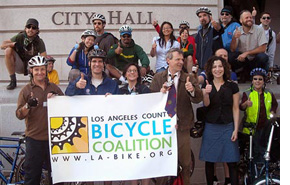 Quick, in 10 words or less, what would you do to make L.A. drivers more aware of the bicyclists sharing the streets with them?
Quick, in 10 words or less, what would you do to make L.A. drivers more aware of the bicyclists sharing the streets with them?
Don’t tell us—tell the Los Angeles County Bicycle Coalition, which is running a Bike Safety Slogan contest. The winner’s words will be immortalized by graphic designer Geoff McFetridge and posted in bus shelters and kiosks around town.
The deadline’s May 5, so don’t wait too long for inspiration to strike. Details are here.
Posted 4-22-10
Making sure bicyclists count on the Orange Line
March 11, 2010
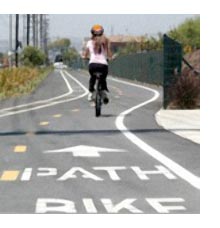 The census has competition—and they’re offering pizza.
The census has competition—and they’re offering pizza.
Metro is seeking volunteers to help conduct a survey of bicyclists, riders and pedestrians on the bikeway next to eight Orange Line stations on March 24 and 27.
To sweeten the deal, they’re hosting a training/orientation session at the Pitfire Pizza in North Hollywood on Monday, March 22 at 7:00 p.m. The pizza’s free and so are the volunteer T-shirts (though you will have to spring for your own beverage.)
The goal is to “document the environmental sustainability benefits that the Metro Orange Line and integrated bikeway have generated since its opening in 2005.”
Those interested in taking part should sign up here.
Posted 3/11/10
Pedaling toward a bike-friendlier L.A.
February 18, 2010
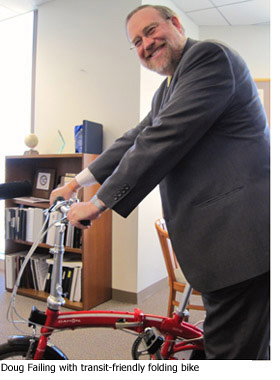 Maybe it’s because he’s a highway guy, but Doug Failing likes to move fast. Real fast. As in “I’ve-only-been-here-30-days-but-I-want-some-new-bike-policies-in-3-to-6-months” fast.
Maybe it’s because he’s a highway guy, but Doug Failing likes to move fast. Real fast. As in “I’ve-only-been-here-30-days-but-I-want-some-new-bike-policies-in-3-to-6-months” fast.
Failing is Metro’s new top highway executive, but he’s also the agency’s interim chief planning officer, and in that capacity he will kick off its first bicycle roundtable on Friday.
To get a preview of what’s in store, and to learn about Failing’s bike philosophy, we dropped by his 22nd floor office at Metro’s Gateway Plaza this week for a chat.
Here are some edited excerpts of what he had to say.
On Los Angeles’ bike-friendliness—or lack thereof
We’re in the C- area. We have a long way that we can go. We’re not a D, or in a failing grade area. We are a dense urban environment. We certainly have our challenges in that we don’t have a lot of separate facilities [bike paths] that I do see in some communities. But quite frankly you don’t need separate facilities.
L.A. is too important to not be striving towards the absolute best in everything that we need to do. We need an A-list transit system. We need an A-list highway system for cars. We need an A-list bicycle transportation system.
We need A-list pedestrian facilities. We have to get there.
On safety and coexistence on the streets
I think the biggest issue that we need to deal with is just overall public education so that our greater [body of] citizens recognize the important role that bicycles play and that they are allowed on streets.
They have rights and they have responsibilities. Both groups–the bicyclists as well as the drivers and pedestrians–all need to know their various rights and responsibilities as they’re commuting.
We’re not at a point where we’re going to create a whole series of new [bike paths.] We will do some new [bike paths], and those are important. But those will only go to a few specific locations.
And bicycles, like people, need to go everywhere. So we need to have methods to get everywhere.
I very much believe in the safety education piece of it. And the coexistence is happening, like it or not, so let’s get over that piece of it and get down to the safety education piece of it.
On where his agency fits in
Metro has a strong role. Our role is to make sure we have a cohesive master plan that covers our entire county.
And more than just the planning, we are a funding source.
So we have money available, which is never a bad thing when you’re trying to get things done.
On how it all fits together
I am a firm believer in a holistic look at how transportation occurs and how our communities develop.
There’s a place for everyone. We all have to be at the table.
On getting things done
I’ve been here 30 days. So I think I should give it more than 30 days. I’d like to see us be able to formulate some good solid policies in the next three to six months…That should be plenty of time.
On the roundtable
Friday’s roundtable for me is the beginning of a better conversation.
I’m hoping that we see a mix of people that can speak on behalf of the casual riders–the more pedestrian, suburban type users–not just the hardcore commuter types, who are important as well.
On his own two wheels
Riding on my street in front of my house—I’ve done that within the last three or four months As far as taking the bicycle out with the family and doing some riding on a bike path, it’s been a couple of years for me.
I’m not gonna be a bicycle commuter. Ain’t gonna happen with me.
I’m more interested in my weekend trips, quite frankly. Of the things I do in my own local community. There’s a lot of stuff that’s really close by the house that I don’t have to fire up the SUV and go truckin’ over to do.
I know the old Schwinn I had as a kid, which was single speed, got me everyplace. And I spent a lot of time on a bicycle as a kid. I think we all did. But there’s a lot more to it than there was back when I was a kid.
Posted 2-18-10
County bike plan workshops set
February 18, 2010
L.A. County’s bikeway master plan is getting a makeover, and the first in a series of community workshops will begin soon.
The objective is to “expand and connect the County network of bikeways, expand existing County-maintained
bicycle facilities, and develop a prioritized list of projects.”
The public workshops will be held in a variety of sites, from Baldwin Park to Topanga, in February and March.
Seeking a better two-wheel vision of L.A.
February 11, 2010
 If you bicycle in Los Angeles, the Metropolitan Transportation Authority needs you.
If you bicycle in Los Angeles, the Metropolitan Transportation Authority needs you.
Specifically, they need you to show up for their first Bicycle Roundtable on Friday, Feb. 19, from 2 p.m. to 4 p.m.
The idea is to “initiate a dialogue and identify issues of importance to cyclists in Los Angeles County that will help create a vision for enhancing Metro’s current bicycle program.”
The meeting comes as bicycles occupy an increasingly important place on the regional transportation agenda, with the city and county of L.A. both creating new master plans for cycling. Bikeways are in the news, too, including a federally-funded bikeway being planned to run from downtown to Santa Monica, adjacent to the Expo Line currently being built.
Doug Failing, former head of Caltrans Bicycle Advisory Committee and now Metro’s New Executive Director of Highway Programs and Interim Chief Planning Officer, will get things started at the roundtable.
There’s bicycle parking at One Gateway Plaza (“between the fish tank/customer service center and Metro elevators”) and lots of public transportation options for getting there (naturally) at the link above.
Let’s take a Great Walk
November 12, 2009
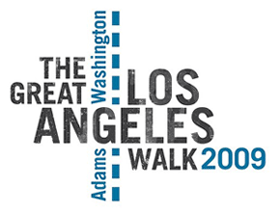 Urban hikers, take note: The Great Los Angeles Walk 2009 is fast approaching, and anyone interested in taking part in the cross-town odyssey (this year’s route runs from the Shrine Auditorium downtown to Venice, by way of some West Adams district architectural sightseeing) should block out about eight hours on their schedule on Saturday, November 21. Read more at
Urban hikers, take note: The Great Los Angeles Walk 2009 is fast approaching, and anyone interested in taking part in the cross-town odyssey (this year’s route runs from the Shrine Auditorium downtown to Venice, by way of some West Adams district architectural sightseeing) should block out about eight hours on their schedule on Saturday, November 21. Read more at
the Franklin Avenue blog or at the Great Walk website.
Here is a video from last year’s event:

Meanwhile, our friends over at Metro’s new blog The Source have created a guide to getting there via public transportation.
Phil’s new red ride
October 31, 2009
Angelenos complain about traffic like urbanites back east complain about the weather. But with apologies to Mark Twain, we’ve found at least one Los Angeles resident with a novel way to actually do something about it.
Phil Hess is a New York transplant who’s lived and worked in L.A. for nearly two decades. For years, the Hancock Park lawyer navigated the city streets as conventionally as the rest of us – comfortably gliding around town encased in his Lexus, but increasingly sweating traffic that seemed to grow exponentially worse by the day.
Today, however, Hess has largely ditched the cushy sedan for a flashier ride: a “Ferrari red” Vespa GTS-250 250-cc motor scooter. And the way he tells it, it was practically love at first sight.
A former planning deputy for retired County Supervisor Ed Edelman, Hess has since built up a thriving private practice as a land-use attorney with cases ranging from Thousand Oaks to the South Bay. “My two most common meetings are meetings with clients or court dates, and the Vespa is essential to be able to do either of those.”
What finally gave him the idea to jump out of the car and onto the scooter?
“I didn’t ditch the car completely,” he admits. “I don’t take the scooter in the rain, and I use the car when I absolutely have to – when I have too much to carry, for example.” But Hess admits that his compulsive New Yorker’s nature can’t abide waiting in traffic – “there, at least it moves; here, it seems to just stop” – and he found LA’s increasingly round-the-clock traffic jams more and more difficult to tolerate.
“What finally snapped my patience,” he says, “was when I had a client in Pacific Palisades with a very complicated land-use issue. There came a time when he couldn’t meet with me until 3 p.m. That evening, I had tickets to a classical concert downtown, and though I left the client at 5:00 p.m., I didn’t get home [to Hancock Park] until 8:15p.”
Anecdotal evidence suggests he’s not alone; Philharmonic officials have long fretted about falling concert attendance among Westsiders due in part to increasingly unmanageable cross-town traffic.
Hess is clearly infatuated with his two-wheel paramour, and eager to show her off.
“The old Vespas were built cheaply and tended to fall apart. They had little two-cycle engines, where you had to mix the gas and oil, and they required a great deal of personal attention to keep running.” As a kid, Hess had plenty of experience with a two-cycle Lambretta, Vespa’s primary competitor. “And if you didn’t get the mix right, ensuring that the engine got enough lubrication, you’d be riding along and the engine would basically seize up into a solid block of metal.”
Subsequent technical advances have largely eliminated that hair-raising possibility while increasing the scooter’s power. What’s more, operating costs are very low. Hess says that, after his roughly $7,000 initial investment, “in three years, I’ve only spent about $300 and tripled my fuel economy.”
So how does a white-collar professional manage to dress for the road and for the board room?
“When I have to meet someone, I get dressed up in layers—I wear well-protective motorcycle boots and stash my dress shoes under the saddle. On a hot day, I’ll put my suit jacket under the saddle and wear a leather jacket. I tried leather chaps once, but they were too uncomfortable.”
Hess concedes that earning a motorcycle license may not be for everyone, with the DMV requiring rigorous testing and training. Then comes the actual practice drills on busy metropolitan streets. Hess shudders at the memory. “You go through six months of absolute terror – Long Beach, Norwalk, Downey, Thousand Oaks. Lomita, Lennox, Hawthorne.” Today, he rides strictly on surface streets: “Although the Vespa technically is freeway legal, it’s totally crazy. I did it once for about 100 yards and got off.”
Cycling safety calls for constant vigilance. “Any kind of spill can be extremely painful,” Hess notes. “The first time I went down, I ripped my suit, and had bruises that took about a month to heal.”
Still, the upsides are considerable, including being able to score great parking spots. “The funny thing is in Italy, where they’re made, nobody rides them anymore – they’re too expensive.”




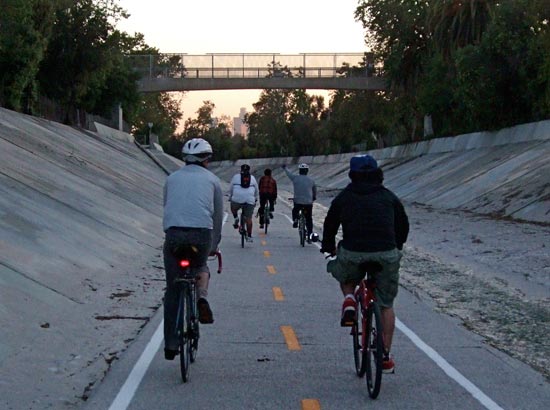
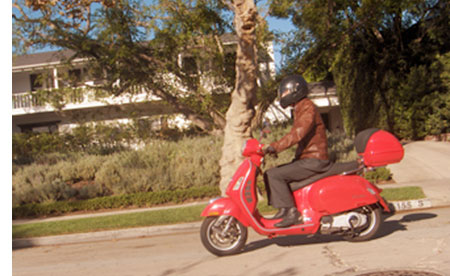
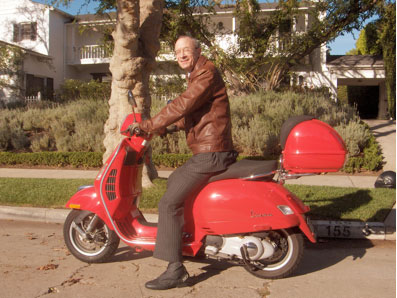







 405 bridge work causes a stink
405 bridge work causes a stink

